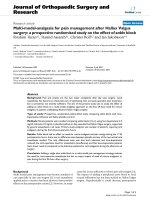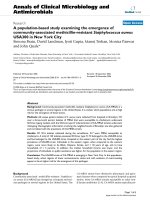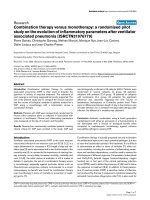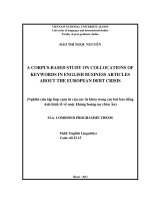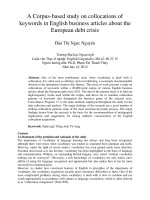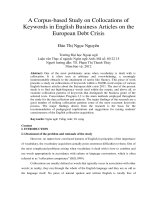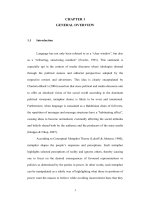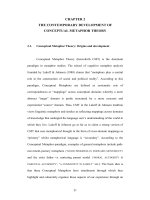- Trang chủ >>
- Thạc sĩ - Cao học >>
- Luật
Legalese or plain language a corpus based study on the language of adhesion
Bạn đang xem bản rút gọn của tài liệu. Xem và tải ngay bản đầy đủ của tài liệu tại đây (3.97 MB, 62 trang )
MINISTRY OF EDUCATION AND TRAINING
HO CHI MINH CITY UNIVERSITY OF LAW
GRADUATION THESIS
B.A. DEGREE IN ENGLISH
Major: Legal English
LEGALESE OR PLAIN LANGUAGE?: A CORPUS-BASED
STUDY ON THE LANGUAGE OF ADHESION
CONTRACTS
Supervisor: NGUYEN THAI SON, MA
Student: TRAN HOANG MY NGOC
Student ID: 1952202010039
Class: 112-LE44(A)
Ho Chi Minh City, 2023
ACKNOWLEDGEMENTS
Looking back on the long journey of my graduation thesis, I am incredibly
fortunate to be among the students who had the opportunity to undertake this thesis.
The journey toward the result of this thesis is an invaluable pursuit, despite the
numerous difficulties and encounters along the way. Instead, this is the journey to
self-development and acquiring a wealth of academic knowledge. However, I
recognize that achieving the best result would not have been possible without the
unwavering support of my supervisor, friends, and family, whose continuous
encouragement propelled me toward constant improvement. Therefore, I want to
express my sincere gratitude to everyone who has supported, guided, and assisted me
throughout my academic journey and the completion of this graduation thesis.
First and foremost, I would like to extend heartfelt gratitude to my supervisor,
Mr. Nguyen Thai Son, for his wholehearted guidance throughout the process of my
graduation thesis. I can confidently assert that the aphorism "Không thầy đố mày làm
nên" (Without your teacher, dare you to succeed) is accurate. I could not have fully
completed this graduation thesis without my supervisor's guidance and
encouragement. I am grateful for his belief in my capabilities. His expertise, profound
knowledge, and unwavering encouragement were instrumental in my journey toward
success. With his dedicated support and invaluable lessons, he guided me in tackling
research problems, constructing a comprehensive and effective research methodology,
and ultimately enabling me to produce a thesis of remarkable quality, of which I am
immensely proud. While words themselves may not adequately express the extent of
my gratitude towards my supervisor, I would like to sincerely convey my profound
appreciation for his guidance throughout my graduation thesis.
Secondly, I am sincerely grateful to my family for their unwavering mental
support throughout my journey toward completing my graduation thesis. Their
emotional and moral encouragement played a pivotal role in bolstering my strength
and resilience, enabling me to overcome moments of anxiety and self-doubt. Their
belief in me and my abilities was a constant source of motivation, instilling the
i
confidence to strive for excellence. Their presence in my life has been a constant
source of comfort and reassurance, and I genuinely appreciate the unwavering support
they have extended to me.
Moreover, I am also thankful to my friends, whose unwavering support,
resources, and facilities were indispensable for completing this graduation thesis.
Among them, I would like to express my special appreciation to Quang Huy, an
automation engineer who played a vital role in assisting me with creating a coding
system that greatly aided in data processing. The access to state-of-the-art materials,
equipment, and facilities provided by my friends has significantly facilitated the
research process and enabled me to accomplish my research goals.
Finally, I want to express my appreciation to other cherished individuals,
whom I cannot entirely mention, who contributed to my academic and personal
growth. Their guidance, feedback, and support have been invaluable in shaping my
journey as a student at Ho Chi Minh University of Law.
ii
LIST OF ABBREVIATIONS
EU
European Union
LPC
Law on Protection of Consumers’ Rights
SEC
The Securities and Exchange Commission
UK
United Kingdom
VCA
The Vietnam Competition Authority
iii
LIST OF TABLES AND PICTURES
Table 1
Synthesis of selected features
Table 2
Description of the corpus design
Table 3
Average number of words per dot
Table 4
The prevalence of relative clauses and conjunctions in contract
corpus
Table 5
Frequency of archaic terms in contract corpus
Picture 1
Icon of AntConc 4.2.0
Picture 2
Graphical user interface of AntConc 4.2.0
Picture 3
CountDot Program
Picture 4
Example of insurance policy (using lists and numbering)
Picture 5
Example of insurance policy (visual cues)
iv
TABLE OF CONTENTS
ACKNOWLEDGEMENTS ........................................................................................ i
LIST OF ABBREVIATIONS ................................................................................... iii
LIST OF TABLES .................................................................................................... iv
CHAPTER 1: INTRODUCTION .............................................................................. 1
1.1 Background to the study ................................................................................... 1
1.2 Research question ............................................................................................. 7
1.3 Significance of the study .................................................................................. 7
1.4 Scope of the study............................................................................................. 7
1.5 Methodology ..................................................................................................... 8
1.6 Structure of the research ................................................................................... 8
CHAPTER 2: LITERATURE REVIEW ................................................................... 9
2.1 Legalese ............................................................................................................ 9
2.1.1 Legalese in general .................................................................................... 9
2.1.1 Legalese in contract ................................................................................. 11
2.2 Plain English ................................................................................................... 14
v
2.2.1 Previous Findings and Recommendations ............................................... 14
2.2.2 Synthesis of selected features .................................................................. 17
CHAPTER 3: DATA AND METHODOLOGY ...................................................... 20
3.1 Data ................................................................................................................. 20
3.2 Methodology ................................................................................................... 22
CHAPTER 4. RESULTS AND ANALYSIS ........................................................... 25
4.1 Design and layout ........................................................................................... 25
4.2 Grammar ......................................................................................................... 26
4.2.1 Lengthy sentences .................................................................................... 26
4.2.2 Complex sentences................................................................................... 27
4.3 Vocabulary...................................................................................................... 29
CHAPTER 5: CONCLUSION AND SUGGESTIONS ........................................... 32
REFERENCES ......................................................................................................... 34
APPENDICES .......................................................................................................... 37
APPENDIX 1: ...................................................................................................... 38
APPENDIX 2: ...................................................................................................... 41
APPENDIX 3: ...................................................................................................... 50
APPENDIX 4: ...................................................................................................... 53
vi
ABSTRACT
The use of legalese has led to the emergence of the Plain English movement,
which aims to simplify the language used in the legal field, particularly in contracts.
Despite extensive discussions on guidelines for more effective drafting, adhesion
contracts still pose specific challenges and face resistance to reform efforts. This is a
study of legalese and plain English within collected adhesion contracts, including
banking, insurance, and employment sector. With an approach drawing on corpusbased research, the study aims to examine to what extent the drafters of sellected
adhesion contracts applied the plain English rule, primarily focusing on the lexical
and structural patterns, including design and layout, grammatical structures, and
archaic words. The findings indicate that collected adhesion contracts have shifted
towards using plain English, employing modern design strategies, eliminating
outdated words, and adopting a concise writing style. However, compared to the
banking and insurance sectors, employment still tends to use more archaic terms,
potentially influenced by legal traditions. This difference can be explained by
prioritizing effective customer communication in the banking and insurance
industries. They recognize the significance of conveying complex financial concepts
and terms in a manner that is easily comprehensible to the general public. The results
of this study support previous linguistic studies, which have recognized and
recommended substituting problematic elements of legal text with plain English
alternatives (Diamond et al., 2010; Adler, 2016; Boginskaya, 2020). However, further
research should be undertaken concerning the other linguistic patterns and usage in
various types of contracts to broaden the research scope. Furthermore, incorporating
qualitative research methods such as interviews or focus groups with contract users
and legal professionals could provide valuable insights into their perceptions and
experiences with different linguistic aspects of contracts.
Keywords: Plain English, Legalese, Legal language, Adhesion contract
vii
CHAPTER 1: INTRODUCTION
1.1 Background to the study
Gibbons (2003) asserts that every area of expertise possess a distinct set of
language characteristics. Legalese or "the customary language used by lawyers in
common law jurisdictions where English is the official language" (Mellinkoff, 2004),
is notoriously employed by legal professionals and individuals involved in legal
proceedings, including jury members, lay judges, and administrators. Despite being
primarily derived from ordinary language, legal language possesses distinct features
that make it suitable for legal purposes (Tiersma, 1999; Mellinkoff, 2004; Tiersma &
Solan, 2012). In other words, although legal language shares similarities in grammar
and vocabulary with everyday language, it differs in syntax, terminology, and writing
style. These are due to the historical development of the law and its tradition-bound
nature. Legalese has evolved to incorporate established conventions and norms,
contributing to its unique character. However, because legal professionals are trained
to understand and navigate this specialized language (often archaic), legalese can
create barriers for the lay public (Tiersma & Solan, 2012).
Over the centuries, lawyers have faced criticism regarding their technical and
conservative writing style, which has even become a source of amusement and
derision. In 1596, an "incident" highlighted efforts to address an excessively verbose
document submitted to an English chancellor's court. Remarkably, the chancellor
ordered a hole cut through the center of the lengthy 120-page text. Furthermore, he
decreed that the document's author should have their head inserted through the hole.
Subsequently, this unfortunate drafter was led in a procession throughout
Westminster Hall, serving as a public spectacle for those in attendance at the court.
This incident is pointed out by Kimble (2023) as a testament to the long-standing
concern and disapproval surrounding the intricacies of legal writing and the need for
clarity and conciseness within the field. In addition, Judge Edward (1992) also
expresses strong criticism, using terms like "appalling" and "awful," regarding the
overuse of legalese in writing. It can be said that dissatisfaction with legal language
1
is not limited to outsiders, as lawyers themselves have expressed a strong dislike for
it (Martínez et al., 2023).
When considering the language of contracts, the potential legal consequences
of this concern become more evident, as it can lead to disputes or detrimentally impact
the parties' interests. Consumers cannot understand the contract's terms, and citizens
often struggle to comprehend the complexities of the law (Black, 1981; Hoffman,
2009). The distinctive characteristics of the contract are highly exceptional. An
eminent English judge, Lord Mansfield, once remarked that "the majority of conflicts
in the world stem from linguistic expressions." Numerous legal conflicts arise from
ambiguous contract language, even when attorneys have been careful in their drafting.
A notable case exemplifying this issue is O'Connor v. Oakhurst Dairy in 2017.
In this case, delivery drivers sued for unpaid overtime wages. The dispute centered
around whether the drivers were covered by an exemption for "packing for shipment
or distribution" under Maine's wage and overtime law. The appellate court found an
ambiguity in the statute's language and interpreted it to refer to a single activity of
"packing." Since the drivers did not engage in "packing," they were not covered by
the exemption.
While some contracts are negotiated between parties with relatively equal
bargaining power, others are designed to favor one party over the other. Adhesion
contracts are widely used as a principal legal instrument to fulfill their intended
purpose, and this format has become an integral component of commercial
transactions and relationships (Patterson, 2010). An adhesion contract is a type of
agreement that presents the terms and conditions to the other party on a "take it or
leave it" basis. This type of contract has become ubiquitous in daily activities,
including mobile phones, insurance, banking services, gym memberships, and other
social activities. Several rationales can explain the rise in the use of these contracts.
Using adhesion contracts can result in lower contracting expenses, including the
expenses of negotiating and drafting the contract (Ben-Shahar, 2007). However, it
possesses both benefits and drawbacks. Due to the absence of mutual negotiation,
adhesion contracts need more meaningful consent from the adhering parties regarding
2
the contractual language. It is customary for corporations, with the assistance of their
legal counsel, to exert substantial diligence in formulating contracts that safeguard
their interests and ensure the efficacious protection of their business concerns,
frequently emphasizing the prevention of encroachment by external parties. However,
the key issue lies in the linguistic attributes intrinsic to adhesion contracts, which
commonly employ specialized legal terminology and technical jargon.
One example is Meyer v. Uber Technologies, Inc. The plaintiff, an Uber car
user, alleged that Uber improperly increased prices by using self-employed drivers,
violating antitrust laws. The district court denied motions by Uber and its former CEO,
Travis Kalanick, to compel arbitration. However, an appeals court ruled that Uber
users must go through arbitration to pursue such claims, reversing the district court's
decision. This case highlights the issue of forced arbitration clauses in lengthy
adhesion contracts, which can limit consumer protections and access to justice. The
enforceability of a click-wrap agreement can be considered a type of adhesion
contract issue, as it involves the terms of a contract being imposed unilaterally by one
party (in this case, the website owner) on the other party (in this case, the user of the
website) without the ability to negotiate or modify the terms. The primary issue at
hand is the need for meaningful consent from customers. Most customers do not read
the standard terms before providing their consent by signing or clicking 'I agree.' Even
for the few consumers who read them, there is doubt whether they can fully
comprehend the terms due to their linguistic complexity.
Although several studies have effectively proven the effectiveness of
recognizing and substituting problematic elements of legal text, such as outdated legal
terminology and intricate sentence structures, with plain English alternatives to
improve understanding among non-experts, their scope is limited to a small fraction
of the overall body of legal language (Charrow & Charrow, 1979; Heuer & Penrod,
1989; Diamond et al., 2010). Conversely, there still have been several opposing views
regarding using plain language instead of legalese in English contracts. Legal
professionals still prefer utilizing legalese as it showcases their expertise. To varying
degrees, many English-speaking lawyers resist the plain English movement and opt
3
to adhere to familiar conventions. This inclination stems primarily from a practical
perspective, as they perceive traditional forms to be more advantageous (Tiersma,
1999).
Furthermore, opponents argue that oversimplifying legal concepts may
compromise precision and subtlety within legal language (Cooter & Ulen, 2011).
Besides, lawyers may refrain from deliberately employing an obscure writing style;
instead, they may be unaware that their language is excessively intricate for the
average reader to grasp (Azuelos-Atias, 2018). Prior research findings support this
hypothesis by demonstrating the influence of factors like prior knowledge and
reading proficiency on the comprehension of specialized texts (Noordman & Vonk,
1992; Kendeou & Van Den Broek, 2007; Ozuru et al., 2009).
Thus, there has been a growing call for Plain English movement in the legal
field, especially in the contractual language. Garner (2013) emphasizes the
importance of using plain English instead of legalese in legal writing: "...prefer the
simple to the complex: Use short words, sentences, and paragraphs. Avoid using legal
jargon and technical terms when simpler language can be used." The author also
argues that legal documents should be written in a way that is accessible to all readers,
rather than relying on specialized legal language that may be difficult for non-experts
to understand. The use of plain language in legal documents has been the subject of
much discussion and research in recent years, with advocates claiming that it
enhances communication, promotes transparency, and reduces misunderstandings
between parties (Cutts, 2020). Further, Kimble (2012) proves that using plain
language can even save businesses and government agencies a ton of money, and
plain language serves and satisfies readers in every possible way.
Regardless of these opposing scholarly views on the Plain Language
movement, various legal jurisdictions have enacted legislative measures to regulate
linguistic usage within standard contract terms, acknowledging the imperative to
address these concerns and promote fairness in contractual relationships. One notable
authoritative instruction is Directive 93/13/EEC on Unfair Terms in Consumer
Contracts ('Directive'). Lying at the heart of the Directive, Article 5 states: "In the
4
case of contracts where all or certain terms offered to the consumer are in writing,
these terms must always be drafted in plain, intelligible language. Where there is
doubt about the meaning of a term, the interpretation most favorable to the consumer
shall prevail."
Given that the party responsible for drafting the adhesion contract is
consistently the supplier or seller, they foresaw comparable objectives to be pursued
through the Contra proferentem doctrine (against the offeror) and a more favorable
interpretation to consumers. This provision reflects the principle of transparency,
which shows the significant focus of European Union (‘EU’) consumer policy on the
paradigm of information provision. The primary objective of this rule is to safeguard
consumers from the inherent danger posed by standard contract terms that conceal
their true meaning (Collins, 2008). Notably, the inspiration behind this formulation
stems from the emergence of transparency requirements in German case law and the
influence of Plain Language movement observed in English-speaking countries
(Hondius, 1995).
In the United Kingdom ('UK'), the Consumer Rights Act 2015 also provides
regulations concerning unfair terms in consumer contracts. Specifically, Section 68
of the Act requires: "(1) A trader must ensure that a written term of a consumer
contract, or a consumer notice in writing, is transparent.; (2) A consumer notice is
transparent for the purposes of subsection (1) if it is expressed in plain and
intelligible language, and it is legible.". To meet this transparency requirement,
German Civil Code (Bürgerliches Gesetzbuch) Article 307 also provide regulation as
follows: "Provisions in standard business terms are ineffective if, contrary to the
requirement of good faith, they unreasonably disadvantage the other party to the
contract with the user. An unreasonable disadvantage may also arise from the
provision not being clear and comprehensible".
In the Vietnamese legal system, particularly in Article 14(2) of the Law on
Protection of Consumers' Rights 2010 ('LPC'), it is stated: "Where a contract is
concluded with consumers in writing, the language of the contract must be clear,
easily understood." From this perspective, businesses are responsible for simplifying
5
any complex language in standard contract forms. They should ensure that it is
transformed into plain and comprehensible terms that can be readily understood by
ordinary consumers with average literacy skills and limited experience.
Even so, the insufficiency of transparency inherent in standard contract terms
may give rise to applying the Contra proferentem rule, which mandates interpreting
such terms in a manner that favors consumers. The comprehensive analysis provided
in the Report on the Regulation on Standard Form Contracts and General Trading
Conditions - The Vietnamese Law and International Experience (2009) by the
Vietnam Competition Authority (‘VCA’) reveals that the language and structure of
terms in adhesion contracts possess the potential to obscure the genuine legal
consequences of clauses that could prove detrimental to the counterparty. This
characteristic
aligns
with
the contra
proferentem doctrine
of
contractual
interpretation, also recognized in Vietnamese law and other legal systems. Under this
doctrine, when a term is ambiguous, the preferred interpretation is the one that
operates to the detriment of the party who formulated the wording. Specifically,
Section 2 Article 405 of the 2015 Civil Code regulates: "if a standard form contract
includes unclear terms and conditions, those terms and conditions should be
interpreted in a manner that favors the party receiving the offer.". Similarly, Article
15 of the 2010 LPC stipulates: "if the provisions of a contract can be interpreted in
multiple ways, the entity or individual responsible for resolving the dispute should
interpret the contract in favor of the consumer." Overall, in cases where multiple
interpretations are possible, the interpretation that is least advantageous to the
supplier will take precedence (Do Giang Nam, 2017).
All in all, the abovementioned provisions obligate companies to undertake a
comprehensive review of their contracts. These rules stipulate that when a contract
contains ambiguous or conflicting clauses arising from language use, the
disadvantage will be bestowed upon the company. This preference is established
through judicial resolution, which favors the non-drafting party.
6
1.2 Research question
To that end, the question being researched in the current study is: “To what
extent have the drafters of selected adhesion contracts applied plain English rules?”
It is hypothesized that the language utilized in adhesion contracts has generally
shifted towards plain English recently, but some legalese terms persist. From an
international perspective, this hypothesis has been previously supported by several
foreign journal studies and reports. For example, Awe & Fanokun (2018) examined
the use of archaic language in legal contracts and its impact on comprehension for
non-lawyers, analyzed ten legal contracts (scanned and converted to electronic
version) from the Akure Judicial Division of Ondo State, Nigeria. They identified 20
archaic terms across four categories, occurring 187 times (2.6% of the total words).
The researchers suggested that modern words should be used instead to cater to the
needs of both lawyers and non-lawyers.
1.3 Significance of the study
Against the backdrop outlined above, the primary significance of the study is
twofold: (1) to assist Legal English learners in understanding the practical aspects of
drafting adhesion contracts, and (2) to provide suggestions aimed at enhancing the
quality of language used in adhesion contracts, with the ultimate goal of enabling
consumers to fully comprehend and grasp the provisions and stipulations of the
agreements they are consenting to.
1.4 Scope of the study
The findings in this study, however, are limited to the contractual language of
adhesion contracts. Particularly, the selection of adhesion contract templates forming
the corpus primarily encompasses prevalent contract types within the domains of
employment, insurance, and banking. However, it is important to note that the study's
scope is limited due to the absence of data on other types of contracts.
7
1.5 Methodology
To test the hypothesis regarding the use of language in adhesion contracts, this
study employs a research method that analyzes adhesion contracts from various
industries. The chosen approach is corpus-based, involving the collection of a large
corpus of text and the utilization of software called AntConc 4.0 to identify patterns
and analyze language usage. The AntConc 4.2.0 software plays a vital role in the
analysis process by providing specialized tools and functionalities designed for
corpus linguistics research. This methodology combines both quantitative and
qualitative analysis. While simple statistical measures are used to determine the
frequency of archaic words within the collected adhesion contracts, the discussion of
structural patterns will be facilitated through visual analysis.
1.6 Structure of the research
Following this introductory part, Section II is devoted to an overview of
legalese and plain English. Section III gives details about the data and methodology
used in this study, followed by the analysis of the results presented in Section IV.
Finally, Section V concludes the study and proposes solutions to address the
persistence of legalese in adhesion contracts.
8
CHAPTER 2: LITERATURE REVIEW
This chapter aims to provide an understanding of the linguistic background relevant
to the research topic. The information will be divided into two sections. The first
section will analyze the characteristics and complexities surrounding legalese in
general and in the contract. In response to the challenges posed by legalese, the
second section will delve into the concept of plain English, which is considered a
solution for eliminating legal jargon and adopting a more straightforward and
accessible writing style using plain language.
2.1 Legalese
2.1.1 Legalese in general
In terms of morpho-lexical features, legal English exhibits a wide vocabulary
range, consisting mainly of highly formal words, archaic terms, loan words, technical
terminology, and collocations, where synonyms or near-synonyms are combined in
binomials. The perception of legalese as a myth is a topic of ongoing debate, as it
encompasses several principal characteristics. Syntactically, legal texts are
intentionally structured to include long sentences, lexical item repetition, complete
significant sentences, and complex sentence structures. Other features are fewer
patterns of spacing, limited punctuation usage, precise, logical sequencing, and the
consistent capitalization of initial words. There are several notable features associated
with legalese, which include the following:
a. Technical vocabulary - Technical or legal jargon, commonly referred to as
terms of art, introduces the misinterpretation and misunderstanding of legal concepts.
These terms, including examples like "Tort," "bailment," and "abatement," are
primarily familiar to legal professionals, but leading to potential difficulties in
comprehending legal language for non-experts.
b. Archaic, formal, and unusual or difficult terminology - Archaic words
such as "darraign," "surrejoinder," and "aforesaid" can introduce ambiguity into
legal documents due to their uncommon usage in everyday English. Legal terms like
"pursuant to" (meaning "under" or "in accordance with"), "prior to" (meaning
9
"before"), "subsequent to" (meaning "after"), and "vel non" (meaning "or not" or "the
lack of it") also fall into this category. Additionally, native expressions beginning
with "here" and "there" (e.g., "therein," "hereunder," "thereof," and "thereto") are
also archaic and rare.
There are a significant number of foreign words and phrases that are primarily
derived from Latin and French. Some of these expressions may appear peculiar or
unfamiliar. Latin has contributed several terms, including "versus," "pro se," "in
propria persona," "caveat emptor," "obiter dictum," and "Amicus Curiae," each of
which carries specific meanings.
c. Impersonal and passive construction - Passive voice and idiosyncratic
pronoun usage signify a distinctively impersonal writing style. While passive voice
is intrinsic to legal language, it is also excessively employed across various forms of
legal documentation.
d. Nominalizations - Verbal nouns are frequently utilized in place of
corresponding verbs within legal discourse. For instance, the phrase "to give
consideration" is employed instead of "to consider," "to be in opposition" rather than
"to oppose," "to be in contravention" in place of "to contravene," and "to be in
agreement" instead of "to agree.". Nevertheless, eliminating nominalization poses a
challenge, as lawyers commonly employ expressions like "to go on arbitration"
instead of simply saying "to arbitrate." This usage stems from recognizing that
arbitration is a legally defined procedure and should be treated as such (Bhatia, 2014).
e. Lengthy and complex sentences - The most noticeable syntactic
characteristics of legal writing reside in the length and complexity of sentences. Such
legal sentences were laden with copious amounts of information, redundancies,
prolonged noun phrases with extensive modification, unconventional word order,
prepositional phrases, and coordinating and subordinating clauses.
Among those features, many scholars agree that one of the most prominent
features of legalese is the use of archaisms, which pose the most significant challenge
in comprehending legal documents (Collins, 2005; Veretina-Chiriac, 2012; Damova,
10
2007). Extensive research has been conducted on loan words by Cornu (2005),
providing contemporary and historical insights into the subject. The intricacies and
nuances of EU legal language have been addressed by Šarčević (2015) within the
context of EU terminology. Additionally, scholars in legal translation, such as
Alcaraz and Hughes (2014), have contributed extensive research on the challenges
and strategies involved in accurately translating legal terms. Specialized national and
international journals, as well as collective works and conference publications,
provide ongoing discussions and examinations of legal terms, enriching the discourse
in the field.
2.1.1 Legalese in contract
However, understanding the most challenging legal characteristics in the
contractual language is more than considering. Legal documents, particularly
contracts, are well-known for their extensive utilization of archaic language, which is
believed to impart a sense of formality and gravity to the contexts in which they are
employed. The linguistic features of legal language in contracts that are most
frequently mentioned are as follows:
a. Frequent employment of archaic and loan words
According to Tiersma (1999), archaic words such as "herein" and "therein"
can contribute to brevity in expression by replacing longer phrases like "in this
document" or "in that clause." As a customary legal document, contracts retain certain
archaic words that are commonplace for lawyers but encountered infrequently by
non-lawyers. In contrast to literary English, where archaic words are rarely utilized,
contract English is replete with numerous archaic terms such as hereby, hereof, hereto,
hereunder, hereinafter, hereafter, thereby, therefrom, thereunder, thereof, therefore,
whereby, and whereof.
In addition, what is particularly distinctive in contract English is the use of
French and Latin legal terms, which have kept their original forms, such as force
majeure, bona fide holder, pro rata tax rate, de facto agreement, etc. One prominent
illustration of this enduring impact is evident in the most recent edition of Black's 18
11
Law Dictionary, published in 2004, which includes a 60-page appendix dedicated to
legal maxims predominantly written in Latin.
Additionally, French has exerted significant influence on legal language due
to its longstanding adoption by English lawyers. A substantial portion of legal
vocabulary is of French origin, encompassing fundamental terms such as "appeal,"
"attorney," "bailiff," "bar," "claim," "complaint," "counsel," and "court." Another
linguistic feature inherited from Law French is the rule of word formation that allows
the creation of a word denoting the recipient or object of an action by appending the
suffixes "-or" or "-er." This phenomenon complements a wide array of related terms
in the legal lexicon, such as "employer/employee," "assignor/assignee,"
"mortgagor/mortgagee," and "lessor/lessee."
However, while technical terms make it difficult for non-lawyers to
understand their meanings, artistic terms help facilitate quick and effective
communication between legal professionals. This enhances internal communication
within the legal community.
b. Wordy and Redundant
One notable characteristic of contract English is synonymous words linked by
the conjunctions "or" or "and." This linguistic phenomenon stems from the diligent
pursuit of precision and exactitude in contractual language (Nida, 2004). Examples
of such word combinations frequently encountered include alteration, modification,
or substitution; loss, injury, or damage; use, misuse, or abuse; terms and conditions;
able and willing; stipulations and provisions; in contract or tort; fraud and deceit;
free and clear; by and between; final and binding, among others. It is argued that in
literary works, strings of synonymous words are sometimes employed to avoid
repetition and showcase language's beauty and artistry.
Moreover, legal discourse is replete with "Doublets and triplets" - tautological
expressions comprising two, three, or occasionally more synonyms that convey
identical meanings. For instance, phrases like "cease and desist," "null and void," or
"fit and proper" are commonly encountered in legal documents. While these
12
combinations may enhance precision and exhaustively address the intended scope,
they can also lead to redundancy and confusion for the readers.
Regarding the syntactic features, Legal English is often characterized by
lengthy sentences that can extend for hundreds of words before reaching a period. An
example of such a sentence can be found in Blackstone's Commentaries, which
includes a 1463-word sentence in an appendix from a 1747 indenture. These lengthy
sentences frequently involve complex embedding, contributing to syntactic
complexity (Mellinkoff, 2004).
c. Overuse of Nominalization and Passive construction
Nominalizations are nouns derived from verbs. They tend to de-emphasize or
obscure the actor, which can reduce comprehension. For instance, in credit contracts,
one might come across language such as "in the event of default on the part of the
buyer...". Here, "default" is a noun, although it can also function as a verb. Using it
as a verb would result in a simpler, shorter sentence that conveys the same message
effectively, such as "If the buyer defaults..." In consumer contracts, it is advisable,
when appropriate, to use personal pronouns like "if you default." Generally, using
verbs instead of nominalized counterparts offers a more direct and efficient means of
conveying information (Tiersma, 1999).
Legal writers often rely on the passive voice in their writing due to its
convenient indirectness. It allows them to obscure the agent of the action or maintain
ambiguity, particularly when multiple agents could be involved, as seen in statutes.
However, using the passive voice can hinder comprehension compared to the active
voice because it disrupts the natural sentence structure.
d. Poor organization
Legal documents are known for their extensive blocks of text without proper
punctuation or indentation, resulting in a visually dense and inaccessible appearance
(Crystal, 2016). The practice of capitalizing entire words is employed to compensate
for the absence of punctuation and emphasize certain terms. However, this approach
13
does not significantly enhance the readability of the text and can lead to confusion
when capitalization is inconsistent or unwarranted (Butt, 2013).
In essence, the Plain language movement advocates for creating documents
with an approachable layout and logical structure written in plain language. These
documents adhere to ordinary contemporary English rules regarding readability,
grammar, vocabulary, and punctuation (Tiersma, 1999; Butt, 2013; Garner, 2013).
The call for simplifying legal language is not a recent development, as numerous
attempts at its reform have been made over the past few centuries.
2.2 Plain English
2.2.1 Previous findings and recommendations
The Plain English movement addresses the ongoing criticisms associated with
the use of legalese in legal context. It is not merely a matter of effective writing but
also a matter of good faith in a contract. Numerous scholars emphasize the importance
of employing plain language, advocating for the use of simple and accessible terms
rather than complex legal jargon. This approach aims to enhance individuals'
understanding of their rights and obligations in legal matters (Adler, 2016). In
contrast, the requirement for "plain and intelligible language" is associated with
clearly presenting contractual terms. This is crucial because if individuals cannot
understand the terms of a contract, their consent cannot be considered fully informed
(Tiersma, 1999). Similarly, Kimble (2016) argues that plain language should be
recognized not as a luxury or optional feature but as an essential tool for fostering
democratic participation.
During the late 1960s and early 1970s, there was a significant surge in the plain
language movement in the United States. This movement gained momentum as an
increasing number of consumers utilized mass media platforms to expose and mock
the complexity of legal documents, aiming to promote the widespread adoption of
plain language. In 1979, Richard Wydick first published Plain English for Lawyers,
pivotal in raising awareness about plain language in the legal profession.
14
Later, Arthur Levitt Jr, the chairman of the Securities and Exchange
Commission (‘SEC’), expressed his frustration with the lack of clarity in disclosure
documents, stating in the Sacramento Bee (1997), "I've been around our markets for
most of my life, and I can't understand much of what passes for disclosure." In
response to this concern, the SEC issued the Plain English Handbook (1998),
providing free guidance to corporations and advocating that they use plain language
in financial documents, such as when drafting critical sections of stock and bond
prospectuses. Also, in New Zealand, some parts of the legislation are being rewritten
in plain English (Williams, 2007).
In A Manual of Style for Contract Drafting, Adams (2004) asserts several
features contributing to optimal contractual language. Some of the significant
grammatical and word features include:
a. Unambiguous language: Contractual language should be unambiguous,
leaving no room for misinterpretation or confusion.
b. Precise terminology: The use of precise and well-defined terms ensures that
the contract accurately captures the parties' intended meaning.
c. Simplicity: The language should be straightforward and free from
unnecessary complexity, avoiding complex sentence structures and excessive use of
legal jargon.
d. Consistent and standardized language: Consistency in terminology,
phrasing, and formatting throughout the contract enhances readability and promotes
a cohesive document understanding.
e. Logical organization: The contract should be logically organized and
structured, with coherent provisions that facilitate comprehension.
f. Completeness: All essential terms and provisions should be included in the
contract, leaving no gaps or ambiguities that could lead to future disputes.
15
g. Contextual awareness: The language should consider the broader context
in which the contract operates, including relevant legal principles, industry practices,
and external factors.
h. Customization: The language should be tailored to the specific needs and
intentions of the parties, reflecting their unique circumstances and requirements.
i. Accessibility: The contract should be written in a manner that is accessible
to the intended audience, avoiding overly technical or archaic language that may
hinder understanding.
j. Readability: Clear typography, appropriate formatting, and adequate
spacing enhance the overall readability of the contract.
Delving into the matter further, Williams (2007) shares a similar perspective
that calls for eliminating archaic, convoluted, and incomprehensible elements of
"legalese" in legal English. In this regard, he puts forth plain language proposals for
legal documents, which encompass the following:
●
Eliminating archaic and Latin expressions
●
Ensuring the text can be understood by someone 'of average intelligence.'
●
Including a 'purposive' clause at the start of the text
●
Reducing the use of the passive
●
Reducing nominalization
●
Replacing shall with must, the semi-modal is/are to construction or the
present simple
●
Ensuring the text is gender-neutral
Based on the recommendations above, considerable research has examined
effective strategies for simplifying legal language aimed at the general public,
including examples such as jury instructions (Diamond et al., 2010; Randall, 2019).
This extensive body of literature delves into approaches and techniques to enhance
16
clarity and comprehension for individuals encountering legal information in these
contexts.
2.2.2 Synthesis of selected features
Among the characteristics mentioned above of legalese found in contracts, it
is vital to note that within a set of randomly selected adhesion contracts, they will be
analyzed on grammatical and lexical aspects and design and layout considerations
because:
Firstly, design and layout play crucial roles in determining the accessibility of
documents. Many traditional legal documents suffer from lengthy paragraphs without
proper punctuation or indentation, resulting in a visually overwhelming appearance
(Crystal, 2016). Additionally, Arbel & Toler (2020) discovered that most standardform agreements employed by significant companies include at least one provision
written entirely in capital letters (all-caps). Therefore, careful attention should be
given to the design and layout of legal documents to ensure that they are visually
appealing, well-structured, and facilitate easy comprehension.
Secondly, regarding sentence length in plain legal documents, Stark (2012)
suggests maintaining sentences between 20 and 25 words. Similarly, Wydick (2005)
emphasizes the significance of keeping the average sentence length below 25 words.
The analysis of sentence length in the contract corpus also considers the presence of
complex sentences. According to the Macmillan Dictionary (2002), a complex
sentence comprises an independent clause and one or more subordinate clauses. The
three main types of complex sentences are adverbial clauses, adjectival clauses, and
noun clauses.
1. An adverbial clause functions as an adverb, modifying the main clause and
providing information about time, place, manner, condition, purpose, or reason. It
typically begins with a subordinating conjunction such as "after," "when," "where,"
because" or "although."
17
